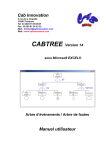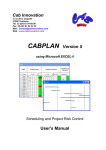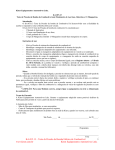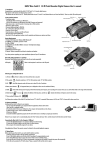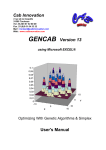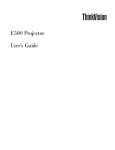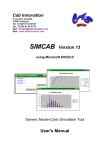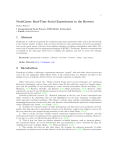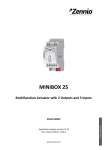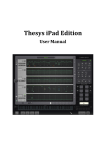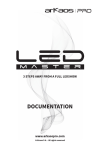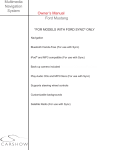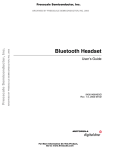Download CABTREE V14 English
Transcript
Cab Innovation 3 rue de la Coquille 31500 Toulouse Tel. 33 (0)5 61 54 68 08 Fax. 33 (0)5 61 54 33 32 Mail : [email protected] Web : www.cabinnovation.com CABTREE Version 14 using Microsoft EXCEL® Fault Tree User's Manual FOREWORD The software CABTREE BASIC version 4 includes some of the CABTREE version 14 features. It is not the subject of a specific user manual The copyright law and international conventions protect the CABTREE software and its User’s Manual. Their reproduction or distribution, either wholly or partly, through any means whatsoever, is strictly prohibited. Any person who does not comply with such provisions is committing an offence of forgery and is liable to prosecution and can be sentenced under the provisions prescribed by the law. The Programming Protection Agency (A.P.P.) references CABTREE at the I.D.D.N. (Inter Deposit Digital Number) index, with the following reference: IDDN.FR.001.070017.00.R.P.2000.000.20600 CONTENTS : 1 The CABTREE Software 1.1 1.2 1.3 1.4 General Presentation Installing CABTREE on Hard Disk Starting CABTREE Symbols used 2 Didacticiel 2.1 2.2 2.3 2.4 2.5 2.6 3 Fault Tree definition Symbology of the Fault Trees Method of calculation Errors to be avoided Monte-Carlo Fault Tree Simulation Step of development of the Fault Trees Entering a Tree 3.1 Entering Using a Table 3.1 Entering Tree Directly 4 Entering Laws 5 Processing a Tree 4.1 Cut Sets 4.2 Calculating the Probability 4.3 Simulation 6 Saving 7 Printing 6.1 Printing the Tree 6.2 Printing the Table 3 1 The CABTREE Software 1.1 General Presentation CABTREE helps achieve and efficiently process the trees of faults or trees of events. Despite its ability to perform right calculations, without any approximation, its original feature consists in integrating a dynamic simulation function of trees (Monte-Carlo). This function in particular makes it possible to treat the gates DELAY (temporization) and AND WITH CONDITIONS (B AND C if B before C). a System loss b c Exclusion e f 2/3 g h i j High length text (256 characters) Program's main features are as follows : • Achieving directly the tree using utilities bars or automatic drawing from a word description preliminarily entered in a table, • Assuming gates OR, AND, NOT, NOR, NAND, exclusive-OR and K among N (drawing of conditioned gates AND and OR and Matrix gate), • Assuming Exponential, Normal, Lognormal, Weibull and Gamma laws to define the occurrence probability of basic events, • Searching cut sets classified according to the occurrence order or probability, • Calculating exactly probabilities (by applying Bayes theorem) over a time interval (curves), 4 • Simulating dynamically the tree (Monte-Carlo) allowing to assume laws of appearance and disappearance of basic elements together with certain dependence relations between events, and to treat the gates DELAY (temporization) and AND WITH CONDITIONS. • Automatic cutting and formatting of the tree or one of its branches for printing. 1.2 Installing CABTREE on Hard Disk Please comply with instructions shown in CD-ROM. 1.3 To Start CABTREE In EXCEL, open file CABTREE.xla. Program functionalities are then made accessible through menu "Tree", spreadsheet functionalities remaining always available. Banner on Excel versions after 2007 Menu on Excel versions prior to 2007 A help and a teachware are proposed in the menu. 5 2 Teachware The teachware presents the Fault Trees by means of various tables and demonstrations. 2.1 Fault Tree definition 6 2.2 Symbology of the Fault Trees 7 Gate Exclusive-OR is defined by a Conditioned OR gate whose condition is "Exclusion". 2.3 Method of calculation 8 2.4 Errors to be avoided 9 10 2.5 Monte-Carlo Fault Tree Simulation 11 2.6 Step of development of the Fault Trees 12 13 3 Entering a Tree The tree may be generated from a word description pre-entered in a table, or achieved directly by assembling different types of events and gates on graph. This second method is recommended. Used with a posterior version of Excel to version 4, the tree can be cut out on several sheets of a work book in order to improve its clearness. 3.1 Entering Using a Table Menu command ″New table″ helps obtaining a table as shown below (ordinary table) : Event ″a″ is the top of the tree, and utilities bars ″Type″ and ″Gate″ are offered to user to create other events and define their type together with the relevant logic gate in the case of rectangle type events. Rectangle Circle Lozenge Double lozenge House Switching of table to relevant tree Activating a button of utilities bar ″Type″ creates a new event, of type chosen by user, on line below the selected cell when this one is in the table. Modifying a type of event already created is made possible by pre-selecting such event in cell of table field ″Type″. 14 OR AND Combination K/N NAND NOR NOT Conditioned-AND Conditioned-OR Delay Matrix Activating utilities bar button ″Gate″ enables to define the logic gate of a rectangle type event. This one commands the display of a dialog box in which user enters the names of events entering in gate (separated by a decimal point): In the case of a conditioned gate or a combination K/N, a second dialog box is used to define gate. The heading of each event may contain up to 256 characters (Press ALT with return to return to line in cell). Probabilities of basic events may be directly entered in relevant field or will be calculated subsequently by program from the laws of probabilities (see chapter "Entering Laws "). Menu command ″Drawing the Tree″ helps drawing the entire tree corresponding to the table, or confining oneself to the drawing of one of its branches, using the dialog box below : 15 Box to be ticked "Deleting previous drawing" helps limiting the number of documents generated from a same table. Values of probabilities pre-entered or calculated by program may be initiated on the generated tree by ticking box "Displaying probabilities". 3.2 Entering Tree Directly Entering a tree directly requires to create preliminarily a blank table before initiating the menu command ″Drawing the Tree ″. So, the dialog box below is initiated to define the top event "a". The same dialog box will be subsequently used to define or modify other tree events. 16 Two scrolling lists help choose among the types of events and logic gates. A third list makes it possible to select or create the events entering the gate. The latter appear in the box located under the name of the gate (separated by commas). In the case of a conditioned gate or a combination K/N, the box just located beneath is used to define the condition (Example : Exclusion), or values of K and N (Example : 3/5). A box to be ticked helps commanding the tree drawing updating (in addition to that of table) after initiating button OK. A second box to be ticked helps limiting this drawing to local modifications when tree structure is not modified (modifications limited to the active sheet when the tree is cut out on several sheets).. After initiating button OK, similar dialog boxes are successively displayed to define the different events entering in gate of event "a". "Circle" type events are offered by default to user and he may modify immediately or subsequently such events from a first drawing. The latter is initiated when all events have been defined. a 3/5 b c d e f Dialog box below is initiated with the tree drawing. Such box helps modifying the tree directly on graph, while updating the relevant table. Buttons' meaning is as follows : Reduces the display zoom factor. Increases the display zoom factor. 17 Cuts an event selected on drawing, as well as the branch which defines it if being of "Rectangle" type. Copies an event selected on drawing, as well as the branch which defines it if being of "Rectangle" type. Adds a pre-cut or pre-copied event, with possibly the relevant branch, to gate events of event selected on drawing. In the case of a pre-copied event, a dialog box helps user to insert directly this one or insert a similar event with same features though with a different name. So, a similar branch is automatically redesigned if it is a rectangle type event. Deletes an event selected on drawing, together with the branch which defines it if of "Rectangle" type. Adds a "Circle" type event to events of gate of the event selected on drawing. Helps event selected on drawing by initiating the pre-described dialog box to define the top event. Such dialog box may also be displayed using simply a ″double click″ on mouse or menu command ″Changing the tree″. Allows to cut out the tree on several sheets of work book on the level of the selected event. This same button makes it possible to remove such a cutting. system of reference between the sheets of the tree makes it possible to pass from an event to its decomposition, and reciprocally, by a simple click of the mouse. Activate the command « Entering Laws» of the menu. Regenerate all events classification (letters) of the tree in order to improve its legibility. Save the table of the tree starting from this last. Commands the printing of tree just the same way as relevant menu command (see chapter "Printing"). 18 Commands the switching of the tree to the relevant table. Menu command ″ Table ↔ Tree Switching″ has a similar effect. 4 Entering Laws Menu command ″Entering Laws" helps defining laws of probability regarding basic-event occurrence using dialog box shown below : Basic events may be selected in the dialog box using a scrolling list. For each event, the user may define the initial condition (0 or 1), a duration, in unit selected, during which the event remains in this condition (After t ≥ 20 hours), as well as a law featuring the change of condition which is chosen using a scrolling list among following probability laws : - Probability (value) → Simple probability value - Exponential (lambda) → With or without periodic maintenance - Normal (average, sigma) - LogNormal (a, b) - Weibull (beta, gamma, sigma) → With or without periodic maintenance - Gamma (beta, lambda) - Availability (lambda, mu) → Availability/Unavailability of an element of fault rate λ and repair rate µ 19 Parameters of laws, entered in parentheses, should be entered respectively in relevant boxes as shown in previous example (Normal law with average 5 hours and standard deviation 1,5 hour). Such parameters are defined in a unit relating to the hour. A box to be ticked helps entering a law of return to initial condition which will only be considered by dynamic simulation function of the tree. Similarly, box "Set / Reset" only concerns simulation. It allows to define a condition of forcing at status 1 or 0 of event considered during transition from 0 to 1 of one or more other events. Acting on button ″OK″ generates the updating of table from information entered in dialog box, then the display of one dialog box specific to simulation function, if one of relevant boxes was ticked (see below), or selection of following basic event. Acting on button ″End / Cancel″ closes such procedure. Entering information specific to simulation function (ignored by calculation function) 20 Periodic maintenance A periodic action of maintenance can be characterized by its effectiveness (probability of repair in the event of failure) and by a possible renovation in the case of elements subjected to degradation or wear. Such a renovation can be modelled by a failure rate of the type: λ = λ (t - ρ k(t)T) with 0 (minimal maintenance) ≤ ρ ≤ 1 (perfect maintenance) in which a virtual age is calculated starting from the last action of maintenance by considering a factor of renovation ρ, corresponding for example to the proportion of the failure rate of the replaced parts. The Exponential and Weibull laws allow to consider such actions of maintenance by the addition of specific parameters: • Exponential (Lambda; Period; Effectiveness) • Weibull (Beta; Gamma; Sigma; Period; Effectiveness; Renovation) 21 5 Processing the Tree 5.1 Cut Sets A cut is a combination of events the achievement of which generates that of event considered. Cut sets represent the smallest combinations leading to such event. So, the tree's top event of page 10 shows the following cut sets : Cuts of a classified in increasing order Order d*~g*~h e*~g*~h f*~g*~h 3 3 3 Symbol ″~″ means negation, operator AND is replaced by ″*″ : d*~g*~h = d AND NOT(g) AND NOT(h) The order is the number of events entering in cut. Menu command ″Cut Sets ″ helps obtaining cut sets of any event of a tree, classified depending on the occurrence order or probability. The event may be preliminarily selected on tree or table, or selected in a dialog box using a scrolling list. Probability of any of cut sets may be obtained whether basic event occurrence probability laws were preliminarily entered. 5.2 Calculating the Probability As soon as basic-event occurrence probability laws are entered, menu command ″Calculating the probability″ allows to calculate the probability of any event of the tree or the factor of importance of the basic events. Such calculation may concern all tree events or be limited to a specific event. In this case, the evolution curve of probability depending on time may be reached by defining in a dialog box the initial time (0 by default), maximum time and the sequence of calculation : 22 Calculation performed by program is an accurate calculation which includes no approximation. Such calculation is based on Bayes theorem which helps calculating the probability of an event from conditional-event probabilities. Its principle is illustrated by the following example in which cut sets are not independent each other (events b and d being identified in different cut sets) : a = b*~c + ~b*d*e + d*f + g P(a) = P(b = 1;d = 1)*P(~c + f + g) + P(b = 1;d = 0)*P(~c + g) + P(b = 0;d = 1)*P(e + f + g) + P(b = 0;d = 0)*P(g) Different importance factors are provided by the tool : - The conditional probability : P(a/ei) (Probability of a knowing the event ei) - The important factor of diagnosis (Vesely et Fussel) : P(ei /a) = Pei * P(a/ei) / Pa - The factor of marginal importance (Birnbaum) : δPa/δPa = P(a/ei)- P(a/not ei) - The critical factor (Lambert) : δPa/δPa = Pei /Pa * [P(a/ei)- P(a/not ei)] - The risk achievement worth : P(a/ei) / Pa - The risk reduction worth : Pa / P(a/not ei) 23 Note : Gate Exclusive-OR is not processed by the calculation function. It is only processed by simulation. 5.3 Simulation Such function helps assessing, using Monte-Carlo simulation, the probabilities of various events of the tree depending on time, together with average values of following typical parameters, within a user-defined time interval : . DUT (Down Up Transition) : average number of transitions from 0 to 1 . UDT (Up Down Transition) : average number of transitions from 0 to 1 . MDT (Mean Down Time) : mean time at condition 0 . MUT (Mean Up Time) : mean time at condition 1 . Average probability It may assume laws of appearance and disappearance of basic events together with certain dependence relations between events (Set / Reset). The gate DELAY (temporization), AND WITH CONDITIONS (B AND C if B before C) and Exclusive-OR can be thus treated by simulation. Events to be assessed may be pre-selected on tree or in table or directly entered in relevant box. The number of simulations (100), the analysis sequence (0,1 hour) and duration of this one (from 0 to 20 hours) are entered by user in relevant boxes. 24 Calculation of average values of preliminarily-defined typical parameters is optional. Time interval during which such values will be calculated is defined by Tmin (10 hours) and Tmax (20 hours). Calculation of accuracy, depending on number of simulations carried out, is also optional. The reliability interval, at level required (60 %), may be calculated for each event. Box to be ticked "Simulation Duration" helps assessing the duration of a simulation together with the overall processing duration for the number of simulations required. Such duration depends mainly on number of transitions of conditions of various events for the analysis duration. Box to be ticked "Debug" allows to obtain the timing diagram of a simulation for test purposes. Following examples illustrate the program's different functionalities. Example 1 : Variable Gate A AND (b,c) - B C Initial Condition Law After t >= Return Law After t >= 0 0 Exp(0,2) Nor(5;2) 0 0 Pro(1) Exp(0,05) 5 0 Results after 100 simulations Average values between Tmin = 10 and Tmax = 20 DUT Sigma(DUT) UDT Sigma(UDT) MDT (hrs) Sigma(MDT) MUT (hrs) Sigma(MUT) Proba. Moy. Sigma(Proba) 25 a b c 0,970 0,699 0,950 0,654 2,979 2,125 3,238 1,784 0,381 0,002 0,900 0,624 0,950 0,589 2,509 1,941 5,000 0,000 0,479 0,003 0,390 0,546 0,290 0,454 4,247 1,518 3,266 1,500 0,833 0,007 Reliability interval Of a (60%) P ± tα P(1 − P) N Example 2 : Variable Dependence a Relation b c Gate AND (b,c) - Initial Condition Law After t >= Return Law 1 0 Exp(0,01) Pro(1) 0 200 Exp(0,04) Pro(1) After t >= Set Reset 0 50 c In this example, event b is forced to status 1 during rising transition (from 0 to 1) of event. If event b is already in status 1, transition of c has no effect. 26 Notes : Operator "Not()" may be used in columns "Set" and "Reset" so that forcing is carried out on decreasing transition of event (from 1 to 0). So c can be replaced by not(c) in previous example. Such operator may be used in a logic gate of type AND, OR, NAND or NOR to facilitate the entry of a simulation table. So, it may be entered AND(b,not(c)) in gate column but such easy step is only allowed for the simulation function. Personalized Probability Laws : In addition to standard probability laws offered to user, the simulation program offers the possibility to construct personalized probability laws. Though, in most cases, such laws can be obtained by combination of standard laws by possibly using dependence relations, they facilitate the processing of generic problems and reduce simulation duration. Entered in the form of de macro-functions EXCEL in file LOI_PERSO\LOI.XLA of PERSO directory, they will be directly read by program during simulations. To write in this ″international additional macro″ type file, pressing ″Shift″ and ″Control″ keys is necessary during the opening (EXCEL procedure). Format used is as follows (example of exponential law) : Perso Law =ARGUMENT("T",1) =ARGUMENT("Waiting",1) =ARGUMENT("Law",2) Exponential =IF(LEFT(Loi,3)="Exp",,GOTO(R[4]C)) =SET.NAME("Lambda",VALUE(LEFT(RIGHT(Law,LEN(Law)-4),LEN(Law)-5))) =SET.NAME("d_T",waiting-(LN(RAND())/Lambda)) =RETURN(D_T) Next function =IF(LEFT(Law,3)="XXX",,GOTO( ) .... Name of functions is limited to 3 characters (Exp). Arguments used are as follows : T : current time, Attente : time of writing in table which adds up to transition time, Loi : name of function and of its arguments as entered in table (decimal points in numbers being replaced by dots : Exp(0.7)). In return, function returns the time before transition (d_T). 27 6 Saving Only the table should be saved as any spreadsheet document. Obviously, the tree saving is not necessary as it may be regenerated by the program from the table, whereas, inversely, obtaining the table from the tree is not possible. 7 Printing 7.1 Printing the Tree Menu command "Printing the Tree" enables to cut and format the tree depending on original document formatting (portrait or landscape). So, the printing documents with a system of cross-reference between pages are generated by the program. In a dialog box, the user selects the printing scale and may keep such documents or command their effective printing. Note : Width of original document columns is stored in printing documents except when the latter is not uniform. 7.2 Printing the Table Menu command "Printing the Table" enables to print the entry table. 28 APPENDIX Application of simulation to problems of the space field As an example, two functions used for evaluating the availability of satellite constellations are originally provided in file LOI.XLA. Function TIR defines the launching date of a satellite and function SAT that of its loss. TIR(Premier_Tir;Retard_si_échec;Fiab_lanceur;Dernier_Tir) Premier_Tir : date of first launch, in years (to be omitted if such date is undetermined). Retard_si_échec : delay prior to next launch, in years, in case of launcher failure (no new attempt in case of omission). Fiab_lanceur : Reliability of launcher (equal to 1 if omitted). Dernier_Tir : late date of a launch in years (to be omitted if it corresponds to the end of simulated mission). The waiting period may be used to simulate the duration prior to a spare satellite launch (see example below). SAT(Fiab_sat;T_Fiab;D_vie) Fiab_sat : Satellite reliability for time T_Fiab (Exponential Law) T_Fiab : Duration corresponding to Fiab_sat (in years) D_vie : Maximum satellite lifetime (in years) Example 3 : Use of personalized probability laws Heading Variable Gate Initial Condition Law After t >= (hours) Return Law After t >= Launch (0;1;0,9;15) Launch (1;1;0,9;15) Launch (2;1;0,9;15) 17520 SAT(0,5;10;10) 0 17520 SAT(0,5;10;10) 0 17520 SAT(0,5;10;10) 0 Service Satellite 1 a b KpN(2/3,b,c,d) - 0 Satellite 2 c - 0 Satellite 3 d - 0 29 Satellite Constellation (2 among 3) 1,2 Probability 1 0,8 Service SAt1 Sat2 0,6 0,4 Sat3 0,2 0 1 2 3 4 5 6 7 8 9 10 11 12 13 14 15 16 17 18 19 20 0 Time (years) Though voluntarily simplified, the example shown below illustrates the program's modelling and simulation capacity. Such generic example describes the problem of renewing satellites in an orbital constellation plan. Example 4 : Simulation of a complex system . Constellation of 2 operational satellites plus a number of spare satellites in orbit . Launching per cluster of 3 . First launch at T = 1 year . Decision of a new launch on loss of any spare . Time allowance before launching : 2 years . Launch Reliability : 0,95 . One year extension in case of failure . Fault rate of an operational satellite ≠ Fault rate of an spare satellite . 8 lifetime years (propellant limitation) 30 Initial Conditio n Law 0 Tir(1;1;0,95) Return Law Ater t >= Set 0 0 Tir(;1;0,95) Pro(1) 17520 1 not(c) not(d) OR(ab,ac) AND(non(a),ab) KaN(2/4,bd,cd,dd,ed) AND(e,non(ad),ag) 0 0 0 Pro(1) Exp(0,000004) Exp(0,00004) 70080 0 0 b,not(af) b,not(af) ae not(ad) ac,not(aa) not(aa) ba bb bc bd be bg bf OR(bb,bc) AND(non(a),bb,non(ab)) KaN(1/3,cd,dd,ed) AND(e,non(bd),bg) 0 0 0 Pro(1) Exp(0,000004) Exp(0,00004) 70080 0 0 b,not(bf) b,not(bf) be not(bd) bc,not(ba) not(ba) Lifetime 3 Sat3 off Sat3 on Sat3 ok Reconf 3 Renewal 3 ca cb cc cd ce cf OR(cb,cc) AND(non(a),cb,non(ab),non(bb)) AND(e,non(cd)) 0 0 0 Pro(1) Exp(0,000004) Exp(0,00004) 70080 0 0 b,not(cf) b,not(cf) ce not(cd) cc,not(ca) not(ca) Lifetime 4 Sat4 off Sat4 on Sat4 ok Reconf 4 Renewal 4 da db dc dd de df OR(db,dc) AND(non(a),db,non(ab),non(bb),non(cb)) AND(e,non(dd)) 0 0 0 Pro(1) Exp(0,000004) Exp(0,00004) 70080 0 0 not(df) not(df) de not(dd) dc,not(da) not(da) Lifetime 5 Sat5 off Sat5 on Sat5 ok Reconf 5 Renewal 5 ea eb ec ed ee ef OR(eb,ec) AND(non(a),eb,non(ab),non(bb),non(cb),non(d AND(e,non(ed)) 0 0 0 Pro(1) Exp(0,000004) Exp(0,00004) 70080 0 0 not(ef) not(ef) ee not(ed) ec,not(ea) not(ea) Heading Variable Gate Service Available First launch Not Renewed Time limit before launching Pulse Renewal a b c d e KaN(2/5,ac,bc,cc,dc,ec) KaN(3/5,ad,bd,cd,dd,ed) - Lifetime 1 Sat1 off Sat1 on Sat1 ok Reconf 1 Condition of renew. 1 Renewal 1 aa ab ac ad ae ag af Lifetime 2 Sat2 off Sat2 on Sat2 ok Reconf 2 Condition of Renew. 2 Renewal 2 Reset Note : The proposed renewal strategy in this example is not optimal as it does not anticipates the end of satellite life. It may be improved simply by considering that a satellite is lost before its real end of life to consider the time allowance before launching (2 years or 4 years to compensate for any possible launching failure). Renewal Process renouvellement Order of renewal : Sat5, 4, 3... 12 10 Sat1 ok Sat2 ok 8 Sat3 ok 6 Sat4 ok 4 Sa5 ok 2 Time bef. launching 0 0 1 2 3 4 5 6 7 8 9 10 11 12 13 14 15 16 17 18 19 20 Time (years) 31 Reconfiguration Process Sat1 off 18 16 Sat1 on 14 Sat2 off 12 Sat2 on 10 Sat3 off 8 Sat3 on 6 Sat4 off 4 Sat4 on 2 Sat5 off 0 1 2 3 4 5 6 7 8 9 10 11 12 13 14 15 16 17 18 19 20 Sat5 on Time (years) Constellation of 2 satellites plus 3 spares 1 0,9 Availability 0 Operating order : Sat1, 2, 3... 0,8 Service 0,7 Sat1 ok Sat2 ok 0,6 Sat3 ok 0,5 Sat4 ok 0,4 Sat5 ok 0,3 0,2 0,1 0 0 1 2 3 4 5 6 7 8 9 10 11 12 13 14 15 16 17 18 19 20 Time (years) Satellite Constellation (Orbit Plan Modelling) 32 OPERATING LICENCE AGREEMENT OF CABTREE SOFTWARE PACKAGE ARTICLE 1 : SUBJECT The purpose of this Agreement is to define the conditions in which the CAB INNOVATION Company grants the customer with a non-transferable, non-exclusive and personal right to use the software package referred to as "CABTREE" and whose features are specified in user's manual. ARTICLE 2 : SCOPE OF THE OPERATING RIGHT The customer may use the software package on one single computer and on a second one provided that the second computer does not operate at the same time as the first one. The customer can only have one software package copy maintained in a safe place as a backup copy. If this license is regarding a performance on site, the customer may install the package software on a server, while scrupulously complying with purchase conditions stated on specific conditions especially defining the maximum number of users authorized to use the software package from their terminal and the maximum number of users authorized to use it simultaneously. The customer is therefore authorized to perform a number of software package documentation copies equal to the maximum number of users allowed to use it.. CAB INNOVATION will be in a position to perform inspections, either itself or through a specialized entity purposefully authorized by CAB INNOVATION, at customer premises to verify if customer has met its requirements : number of software package copies used, location of such copies, etc... Parties will agree as regards the practical modalities of performance of such inspections so as to disturb minimally customer's activity. ARTICLE 3 : DELIVERY, INSTALLATION AND RECEPTION The software package and attached supplies will be delivered to the customer on mail reception date. The customer installs, at its own costs, the software package using relevant manual delivered by CAB INNOVATION. The customer performs the inventory and shall inform CAB INNOVATION, within three working days of the delivery, of any apparent nonconformity with respect to the order. The customer is liable for any loss or any damage caused to supplies as from the delivery. ARTICLE 4 : TESTING AND GUARANTEE Guarantee is effective as from the mail delivery date set forth in Article 3 and has a three-month validity. During the guarantee validity, if the customer experiences a software package operation trouble, he should inform CAB INNOVATION about it, so as to receive any helpful explanations with the purpose of remedying such trouble. If the trouble is continuing, the customer will return the C.D. ROM to CAB INNOVATION, at CAB INNOVATION's Head Office, at his own expense and with registered mail with acknowledgement of receipt, by specifying exactly the troubles encountered. Within the three months of reception of consignment set forth in preceding paragraph, CAB INNOVATION will deliver, at its own expense, a new product version to the customer. This new version will be benefiting of the same guarantee as benefited the first version. The customer looses the benefit of the guarantee if he does not comply with the instructions manual recommendations, if he performs modifications of configuration set forth in Article 2 above without obtaining a prior written consent from CAB INNOVATION, or if he performs modifications, additions, corrections, etc... on software package, even with the support from a specialized service company, without obtaining a prior written consent from CAB INNOVATION. ARTICLE 5 : PROPERTY RIGHT CAB INNOVATION declares to be holding all the rights provided for by the intellectual property code for CABTREE package software and its documentation. As this operating-right granting generates no property-right transfer, the customer abstains from : - any CABTREE software package reproduction, whether it is wholly or partly carried out, whatever the form assumed, excepting the number of copies authorized in Article 2 ; - any CABTREE software package transcription in any other language than that provided for in this Agreement (see Appendix), any adaptation to use it in other equipment or with other basic software packages de base than those provided for in this Agreement. To ensure this property protection, the customer undertakes especially to 33 - maintain clearly visible any property and copyright specifications that CAB INNOVATION would have affixed on programs, supporting material and documentation ; - assume with respect to his staff and any external person any helpful information and prevention step. ARTICLE 6 : USING SOURCES Any CABTREE software package modification, transcription and, as a general rule, any operation requiring the use of sources and their documentation are exclusively reserved for CAB INNOVATION. The customer holds the right to get the information required for the software package interoperability with other softwares he is using, under the conditions provided for in the intellectual property code. In each case, an amendment of these provisions will set out the price, time limits and general terms of performance thereof. ARTICLE 7 : LIABILITY The customer is liable for : - choosing CABTREE software package, its adequacy with his requirements, precautions to be assumed and back-up files to be made for his operation, his staff qualification, as he received from CAB INNOVATION recommendations and information required upon its operating conditions and limits of its performances set forth in user's manual; - the use made for results he obtains. CAB INNOVATION is liable for the software package conformity with his documentation. The customer shall prove any possible non-conformity. CAB INNOVATION does not assume any whatsoever guarantee, whether explicit or implicit, relating to the software package, manuals, attached documentation or any supporting item or material provided and, especially, any guarantee for marketing of any products relating to software package or for using software package for a determined use, any guarantee for absence of forgery, etc... Under no circumstances CAB INNOVATION could be held responsible for any whatsoever damage, especially loss in performance, data loss or any other financial loss resulting from the use or impossibility to use the CABTREE software package, even if CAB INNOVATION was told about the possibility of such damage. In the event where CAB INNOVATION liability is retained, it is expressly agreed upon that the total amount of compensation to be paid by CAB INNOVATION, all cases taken together, could not in any way exceed the initial-royalty price reduced by 25 % per period of twelve months elapsed as from the mailing delivery date. ARTICLE 8 : DURATION This Agreement is entered into for an undetermined period of time as of the date set forth in Article 3. ARTICLE 9 : TERMINATION Each party may terminate this Agreement, by registered mail with acknowledgement of receipt forwarded to the other party, for any breach by such party of its obligations, despite a notice remaining unresponsive for 15 days, and this occurring with no prejudice to damages it could claim and provided that the last paragraph of Article 7 above, be enforced. At end of this Agreement or in case of termination for whatsoever reason, the customer will have to stop using CABTREE software package, pay all sums remaining due on date of termination and return all elements composing the software package (computer programs, documentation, etc ... ) without maintaining any copy of it. ARTICLE 10 : ROYALTY As a payment for the operating-right concession, the customer pays CAB INNOVATION an initial royalty the amount of which is determined in specific conditions. ARTICLE 11 : PROHIBITED TRANFER The customer refrains from transferring the software package operating right granted personally to him by these provisions. The customer also abstains from making documentation and supporting material (CD ROM), even free of charge, available to a person not expressly set forth in second paragraph of Article 2. ARTICLE 12 : ADDITIONAL SERVICES Any additional services will be subject to an amendment of these provisions, possibly through an exchange of letters, so as to specify the contents, modalities of achievement and the price. ARTICLE 13 : CORRECTIVE AND PREVENTIVE MAINTENANCE 34 The corrective and preventive maintenance may be subject, upon customer's request, to a separate Agreement attached to these provisions. ARTICLE 14 : ENTIRETY OF THE AGREEMENT The user's manual defining the CABTREE software package features is appended to these provisions. The provisions of this Agreement and his Appendix express the entirety of the Agreement entered into between the parties. They are prevailing among any proposition, exchange of letters preceding its signing up, together with any other provision stated in documents exchanged between the parties and relating to the Agreement's subject matter. If any whatsoever clause of this Agreement is null and void with respect to a rule of Law or a Law in force, it will considered as not being written though not involving the Agreement's nullity. ARTICLE 15 : ADVERTISING CAB INNOVATION could mention the customer in its business references as a CABTREE software package user. ARTICLE 16 : CONFIDENTIALITY Each party undertakes not to disclose any kind of documents or information about the other party that it would have been informed of on the Agreement's performance and undertakes to have such obligation fulfilled by the persons it is liable for ARTICLE 17 : AGREEMENT'S LANGUAGE This Agreement is entered into and drawn up in the French language. In the event where it is translated into one or more foreign languages, only the French text will be deemed authentic in case of any dispute between the parties. ARTICLE 18 : APPLICABLE LAW - DISPUTES The French Law governs this Agreement. In the event of any disagreement over the interpretation and performance of any whatsoever provision of this Agreement, and if parties fail to reach an agreement under an arbitration procedure, only Toulouse’s Courts will be competent to settle the dispute, despite the plurality of defendants or the appeal for guarantee. 35



































